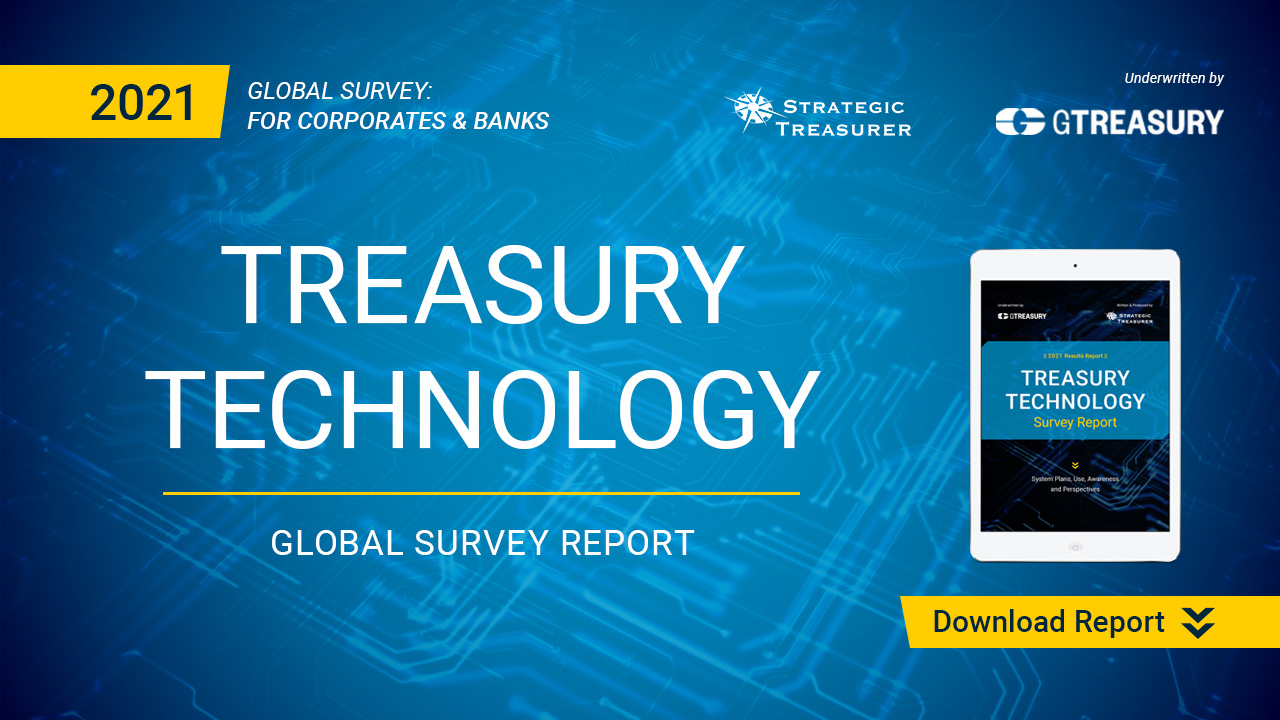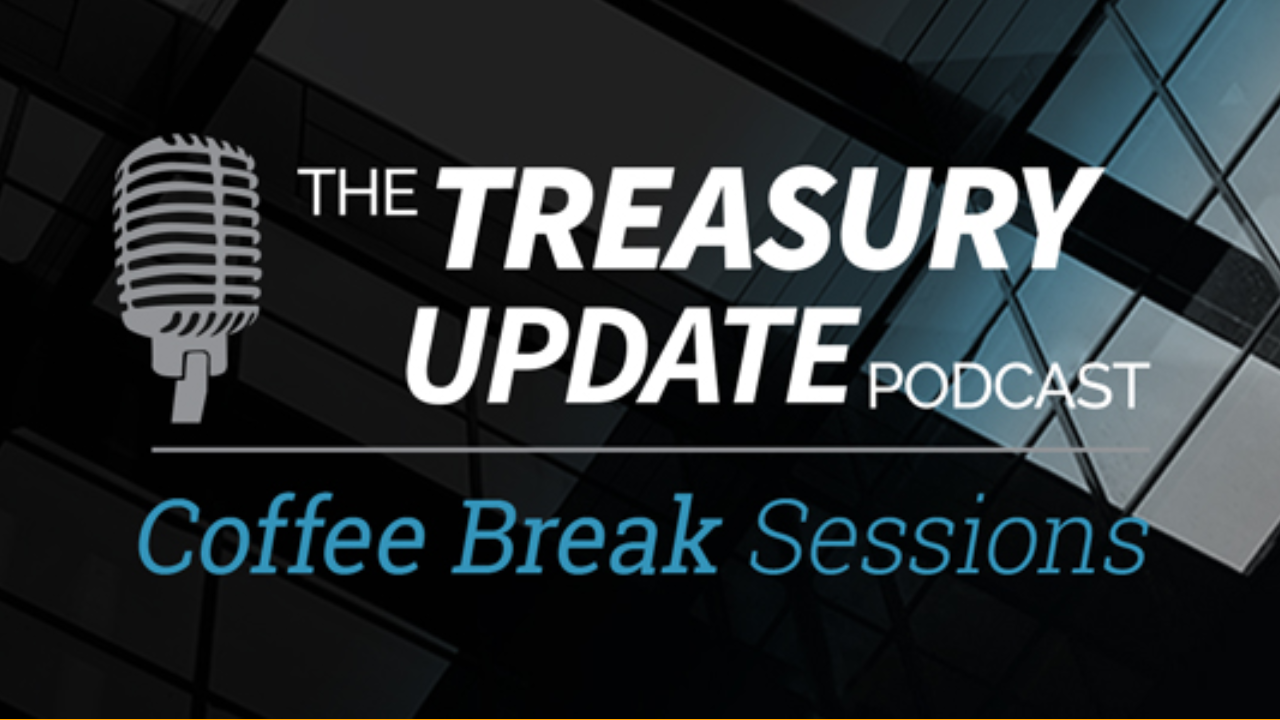
Session 43
Coffee Break Session:
What Is Straight-Through Processing?
Host:
Alexa Cook, Strategic Treasurer


Speaker:
Craig Jeffery, Strategic Treasurer


Episode Transcription - (Coffee Break Session Series) Episode 43 - What is Straight Through Processing
Alexa Cook 0:21
Guys, welcome to The Treasury Update Podcast Coffee Break session, the show where we cover foundational Treasury topics and questions in about the same amount of time it takes to drink your coffee. This is your host, Alexa and I’m joined today with Craig Jeffery, managing partner of Strategic Treasurer. Welcome back, Craig.
Craig Jeffery 0:39
Thanks Alexa.
Alexa Cook 0:41
Yeah, thanks for joining me today. Today we’re going to shift away from the accounting topics that we’ve sort of been covering more recently and we’re going to shift towards straight-through processing. So, Craig, if you could just kick it off and maybe talk us through “What is straight-through processing?”
Craig Jeffery 0:58
Yeah, I don’t know if I have a short definition, but straight-through processing means to us that, you know, the process has a system-to-system handoff that’s digital, we’re not dumping things out of one system onto paper and re-entering them. It’s going from system to system in an integrated manner, which is the key for what straight through processing is. And you can look at straight through processing as something that’s internal in a company, so there’s not the handoffs, not the physical handoffs from one area to another, or you can also look at it from outside the organization so an end to end to an end-to-end approach looking at your other trading partners process as well.
Alexa Cook 1:47
Okay. How does it work, or you want to maybe give a little more detail on that?
Craig Jeffery 1:51
If it’s within inside your organization it’s, you know, where you have handoffs of information or data or even if it’s completely integrated in one system, it’s the process, it’s the idea that as something is processed and whether it moves along in a linear fashion where, you know, data, or a business document or information is moving from one system or process to another, it moves along digitally and doesn’t have to be reformatted or enriched with information very much. It becomes the data moves from one system to another, if it’s multiple systems. If that’s internal. That’s one aspect. If everything resides in the same system and you’re looking at the same records, you’re just enriching the same data set. That’s another way of converting the process to more straight through because you’re all looking at the same version of the data. And it’s processing that way, what it looks like between organizations, it could still be using something like EDI or XML messages or sending things back and forth in business document that’s an electronic form that you both agree to the standard. In other words, what’s the structure of the message or the structure of the data, and what’s contained in the data or the data dictionary that’s used to communicate that information. Maybe we should think of this in terms of conversations. I want to order something. What do you want to order? I want to order these things at this price for this amount in this color. Your orders confirmed. We’ve shipped, these items to you. Here’s an invoice for these items with these amounts. And then when you’re making the payment here’s the payment, here’s what we’re paying for here’s the discount we took that you didn’t have, or we marked an item that came in damage so we paid you less. Here’s what we paid you less for. Instead of these being conversations or emails, or scribbles on paper or printed documents now that information is going back and forth electronically these conversations and dialogues are happening, digitally. And it’s a key part of efficiency, the straight through processing where the systems can handle all of the activity, there’s very few errors or defects that have to be handled by person,
Alexa Cook 4:18
Where’s the value in the straight through processing? Is it saving companies money or is it maybe more of a time saver?
Craig Jeffery 4:24
Yeah, I think it saves both time and money. From the time side, there’s not just the efficiency of a clean process that runs from one end to the other, where the digital version is better than the manual version. Both of those could be a clean process but the digital version is quite a bit more streamlined and more efficient but that’s one aspect. The other element of time has to do with what creates the most time loss. Well, those are defects or errors in a process and what creates defects, well, a bad process and a bad process could be something that’s manual, a poorly designed process can, by design, create defects, so it’s not, it’s not thought through as well, whether it’s a hybrid type of process or it’s really straight through or, or whether it’s manual in nature, but those, those errors, add significant time and cost to the process. So, think about that for a minute as you create an error. Let’s say your remaining payment errors come out. Now someone has to call you and say I don’t know how to apply the payment you sent in, or you’re shipping goods and there’s your invoice has the wrong information or the order comes in correct all those things require repairs, maybe loss of goods but certainly a lot of time. Anytime you create a defect, people are getting involved, usually people from both sides of the transaction, either inside a company or outside. So, that’s a that’s a key part of the time, which translates to money. The other side is related to the relationship. Cleaner process you’ll do more business with those parties, you’ll have a better counterparty relationship. And if you have a cleaner process, it makes it more affordable for the other party to do business with you. They get more efficient and that’s a pretty virtual virtuous cycle of transactions. The other side, and I don’t think people know this as well by looking through it, it can be logical, when you think about it, but this idea of, if you have more errors or more defects which you have less of with straight through processing but where do you save money, you also save money and on the working capital side the amount of margin, you have to put to handle the fact that you don’t know when you’re going to get paid, or why there’s a delay or an issue. And I think of some different examples that we’ve done, we’ve worked with companies who’ve looked at these processes and we’ve moved to any digital end to end process you know order to payments that reduces the errors, and I may have the…it’s been a few years now since I’ve looked at the case study, but, you know, The organization had a DSO, something along the lines of 40 something days.
And, you know, that’s great, their terms were 30 so it was 12 days of sales outstanding higher than what the terms are. And so, converting people to digital methods of sending invoices, receiving payments, allow for much, much faster and you know from ordering to invoicing to payment, allow for a much much faster process and it’s not like people started paying early they weren’t paying before 30 days but they paid much much closer to terms. And what happened is, even though they hadn’t converted everyone to digital, the change in DSO was dramatic. It was many, many days of the 12 extra was reduced, and part of that reason was, as you know if you have a manual process, well what happens? Paper. Paper doesn’t get there as quick, if there’s any type of defect, any type of error in a manual process like look what happens. Let’s just look at the AP side, if a person is processing something, there’s an error, like oh I gotta send a note, I stick it over to my exception file where I know I need to send a note saying you charged me the wrong amount or this, this number, or item didn’t agree. And so that gets handled a day later, it gets sent over by email, and then the new invoice is generated and then sent in and that therefore enters this either physical stack or just the schedule that occurs when things are eventually scanned in. So, the defect, the defect has a disproportionate impact on working capital, on the flow and efficiency of an organization. So, that’s one type of example of the value that reducing errors has, and producing errors is best done by this straight through processing, not only internally but with your trading partners.
Alexa Cook 9:40
At least when I was in the practitioner side of things, anything that was, you know on the working capital side as a benefit was, was major. So, I appreciate you bringing that point of it, Craig. So just to kind of take a quick recap on our topic covered today. What is straight through processing? So it’s really a process that has a system the system handoff that’s digital it’s typically integrated and you know it can be internal within a company or external which would be an end to end process and in short on how it works it’s really moving along digitally, it doesn’t have to be something that’s enriched for what it is between organizations that can use PDI or XML it’s just something that’s agreed upon as far as the structure goes. And you just really went through a lot of the value in those details, especially on that DSO side, but I think some of those main points was that there can be a large time benefit, and, you know, not as many people sort of touching things and, you know, less prone to errors. Was there anything else you wanted to add there?
Craig Jeffery 10:42
No, I appreciate the time thanks for talking about.
Alexa Cook 10:46
Yeah, thanks for joining us today, Craig and to all of our listeners thanks for tuning in and make sure you join us back every first and third Thursday of the month for a new episode and as always, we appreciate hearing your comments and feedback so you can send us an email at podcast@strategictreasurer.com Thanks again, Craig.
OUTRO 11:07
This podcast is provided for informational purposes only, and statements made by Strategic Treasurer LLC on this podcast, are not intended as legal business consulting or tax advice. For more information, visit and bookmark Strategictreasurer.com.
Strategic Treasurer and GTreasury are proud to present the findings from the Treasury Technology Survey with data from over 250 respondents operating primarily across North America and Europe. This annual study polls treasury and finance professionals on their views regarding the technology drivers and challenges and system plans, use, and needs.
A part of the Treasury Update Podcast, Coffee Break Sessions are 6-12 minute bite-size episodes covering foundational topics and core treasury issues in about the same amount of time it takes you to drink your coffee. The show episodes are released every first and third Thursday of the month with Special Host and Treasury Consultant Alexa Cook of Strategic Treasurer.




